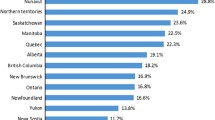Summary
It is recognized that prenatal care plays an important role in reducing adverse birth. Chinese pregnant women with medical condition were required to seek additional health care based on the recommended at least 5 times health care visits. This study was to estimate the association between prenatal care utilization (PCU) and preterm birth (PTB), and to investigate if medical conditions during pregnancy modified the association. This population-based case control study sampled women with PTB as cases; one control for each case was randomly selected from women with term births. The Electronic Perinatal Health Care Information System (EPHCIS) and a questionnaire were used for data collection. The PCU was measured by a renewed Prenatal Care Utilization (APNCU) index. Logistic regression models were used to estimate odds ratios (OR) and the 95% confidence interval (95% CI). Totally, 2393 women with PTBs and 4263 women with term births were collected. In this study, 695 (10.5%) women experienced inadequate prenatal care, and 5131 (77.1%) received adequate plus prenatal care. Inadequate PCU was associated with PTB (adjusted OR: 1.41, 95% CI: 1.32–1.84); the similar positive association was found between adequate plus PCU and PTB. Among women with medical conditions, these associations still existed; but among women without medical conditions, the association between inadequate PCU and PTB disappeared. Our data suggests that women receiving inappropriate PCU are at an increased risk of having PTB, but it does depend on whether the woman has a medical condition during pregnancy.
Similar content being viewed by others
References
Richard EB, Adrienne SB, Editors. Preterm Birth: Causes, Consequences, and Prevention. National Academies Press. http://www.nao.edu/catalog/11622.html
Soilly AL, Lejeune C, Quantin C, et al. Economic analysis of the costs associated with prematurity from a literature review. Public Health,2014,128(1):43–62
Khan KS, Honest H. Risk screening for spontaneous preterm labour. Best Pract Res Clin Obstet Gynaecol, 2007,21(5):821–830
Alexander GR, Kotelchuck M. Assessing the role and effectiveness of prenatal care: history, challenges and directions for future research. Public Health Rep, 2001,116(4):306–316
Tayebi T, Zahrani ST, Mohammadpour R. Relationship between adequacy of prenatal care utilization index and pregnancy outcomes. Iran J Nurs Midwifery Res, 2013,18(5):360–366
Zhang S, Cardarelli K, Shim R, et al. Racial disparities in economic and clinical outcomes of pregnancy among Medicaid recipients. Matern Child Health J, 2013,17(8):1518–1525
Clarke LL, Miller MK, Albrecht SL, et al. The role of medical problems and behavioral risks in explaining patterns of prenatal care use among high-risk Women. Health Serv Res, 1999, 34(1 Pt 1):146–170
Taylor CR, Alexander GR, Hepworth JT. Clustering of U.S. women receiving no prenatal care: differences in pregnancy outcomes and implications for targeting interventions. Matern Child Health J, 2005,9(2):125–133
Frisbie WP, Echevarria S, Hummer RA. Prenatal care utilization among non-Hispanic whites, African Americans, and Mexican Americans. Matern Child Health J, 2001,5(1):21–33
Partridge S, Balayla J, Holcroft CA, et al. Inadequate prenatal care utilization and risks of infant mortality and poor birth outcome: aretrospective analysis of 28,729,765 U.S. deliveries over 8 years. Am J Perinatol, 2012,29(10):787–794
Petrou S, Kupek E, Vause S, et al. Antenatal visits and adverse perinatal outcomes: results from a British population-based study. Eur J Obstet Gynecol Reprod Biol, 2003,106(1):40–49
Heaman MI, Newburn-Cook CV, Green CG, et al. Inadequate prenatal care and its association with adverse pregnancy outcomes: a comparison of indices. BMC Pregnancy Childbirth,2008,8:15
McDuffie RS, Beck A, Bischoff K, et al. Effect of frequency of prenatal care visits on perinatal outcome among low-risk women: A randomized controlled trial. JAMA, 1996,275(11):847–851
Debiec KE, Paul KJ, Mitchell CM, et al. Inadequate prenatal care and risk of preterm delivery among adolescents: a retrospective study over 10 years. Am J Obstet Gynecol, 2010,203(2):122.e1–6.
Rouget F, Lebreton J, Kadhel P, et al. Medical and sociodemographic risk factors for preterm birth in a French Caribbean population of African descent. Matern Child Health J, 2013,17(6):1103–1111
Heaman M, Kingston D, Chalmers B, et al. Risk factors for preterm birth and small-for-gestational-age births among Canadian women. Paediatr Perinat Epidemiol, 2013,27(1):54–61
Bloch JR, Dawley K, Suplee PD. Application of the Kessner and Kotelchuck prenatal care adequacy indices in a preterm birth population. Public Health Nurs, 2009,26(5):449–459
VanderWeele TJ, Lauderdale DS, Lantos JD. Medically induced preterm birth and the associations between prenatal care and infant mortality. Ann Epidemiol, 2013,23(7):435–440
Vieira CL, Coeli CM, Pinheiro RS, et al. Modifying effect of prenatal care on the association between young maternal age and adverse birth outcomes. J Pediatr Adolesc Gynecol, 2012,25:185–189.
Li C, Wu ZC, Lei P, et al. Adequacy index of prenatal care utilization and its application. Zhongguo Fuyou Baojian (Chinese), 2010,25(7):878–880
Nwaru BI, Wu Z, Hemminki E. Determinants of the use of prenatal care in rural China: The Role of Care Content. Matern Child Health J, 2012,16(1):235–241
Nwaru BI, Wu Z, Hemminki E. Infant care practices in rural China and their relation to prenatal care utilization. J Globe Public Health, 2011,6(11):1–14
Acknowledgements
We appreciated the hard work of all the staffs of maternal and child health care in the District Maternal and Child Health Care Hospitals and Community Health Service Centers in inner-city, Wuhan, China.
Author information
Authors and Affiliations
Corresponding authors
Additional information
This study was sponsored by the Health Effects Institute, US (No. #4791-RFA09-2/10-5) and Hubei Provincial Natural Science Foundation of China (No. 2010CDB08803).
Rights and permissions
About this article
Cite this article
Zhang, B., Yang, R., Liang, Sw. et al. Association between prenatal care utilization and risk of preterm birth among Chinese women. J. Huazhong Univ. Sci. Technol. [Med. Sci.] 37, 605–611 (2017). https://doi.org/10.1007/s11596-017-1779-8
Received:
Revised:
Published:
Issue Date:
DOI: https://doi.org/10.1007/s11596-017-1779-8




